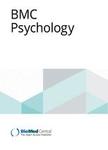版权所有:内蒙古大学图书馆 技术提供:维普资讯• 智图
内蒙古自治区呼和浩特市赛罕区大学西街235号 邮编: 010021

作者机构:Kyoto University Department of Physical Therapy Human Health Sciences Graduate School of Medicine Kyoto Japan Japan Society for the Promotion of Science Tokyo Japan Keio University Department of System Design Engineering Yokohama Japan Rehabilitation Center Fujioka General Hospital Gunma Japan Nozomi Orthopaedic Clinic Hiroshima Japan Nozomi Orthopaedic Clinic Studium Hiroshima Japan Nozomi Orthopaedic Clinic Hiroshima Hiroshima Japan Kyoto University Department of Orthopaedic Surgery Graduate School of Medicine Kyoto Japan
出 版 物:《BMC Psychology》 (BMC Psychol.)
年 卷 期:2018年第6卷第1期
页 面:19页
基 金:Japan Society for the Promotion of Science, KAKEN, (17J03084) Japan Society for the Promotion of Science, KAKEN Ministry of Education, Culture, Sports, Science and Technology, MEXT Ministry of Health, Labour and Welfare, MHLW
主 题:Depression Functional limitation Knee osteoarthritis Knee pain Physical activity
摘 要:Background: Depressive symptoms are a major comorbidity in older adults with knee osteoarthritis (OA). However, the type of activity-induced knee pain associated with depression has not been examined. Furthermore, there is conflicting evidence regarding the association between depression and performance-based physical function. This study aimed to examine (i) the association between depressive symptoms and knee pain intensity, particularly task-specific knee pain during daily living, and (ii) the association between depressive symptoms and performance-based physical function, while considering other potential risk factors, including bilateral knee pain and ambulatory physical activity. Methods: Patients in orthopaedic clinics (n=95;age, 61-91 years;67.4% female) who were diagnosed with radiographic knee OA (Kellgren/Lawrence [K/L] grade≥1) underwent evaluation of psychological health using the Geriatric Depression Scale (GDS). Knee pain and physical function were assessed using the Japanese Knee Osteoarthritis Measure (JKOM), 10-m walk, timed up and go (TUG), and five-repetition chair stand tests. Results: Ordinal logistic regression analysis showed that depression, defined as a GDS score≥5 points, was significantly associated with a worse score on the JKOM pain-subcategory and a higher level of task-specific knee pain intensity during daily living, after being adjusted for age, sex, body mass index (BMI), K/L grade, and ambulatory physical activity. Furthermore, depression was significantly associated with a slower gait velocity and a longer TUG time, after adjusting for age, sex, BMI, K/L grade, presence of bilateral knee pain, and ambulatory physical activity. Conclusions: These findings indicate that depression may be associated with increased knee pain intensity during daily living in a non-task-specific manner and is associated with functional limitation in patients with knee OA, even after controlling for covariates, including bilateral knee pain and ambulato